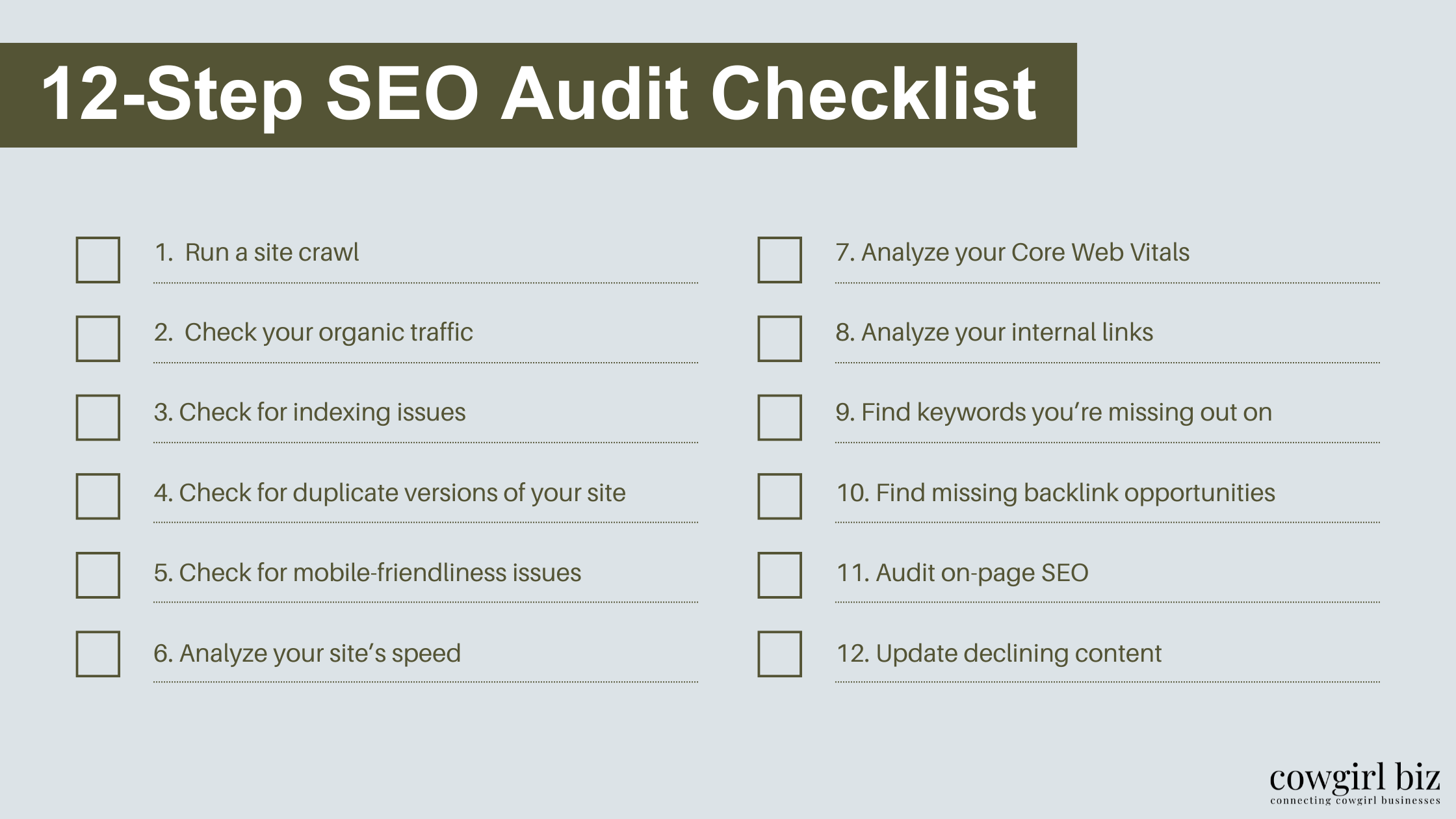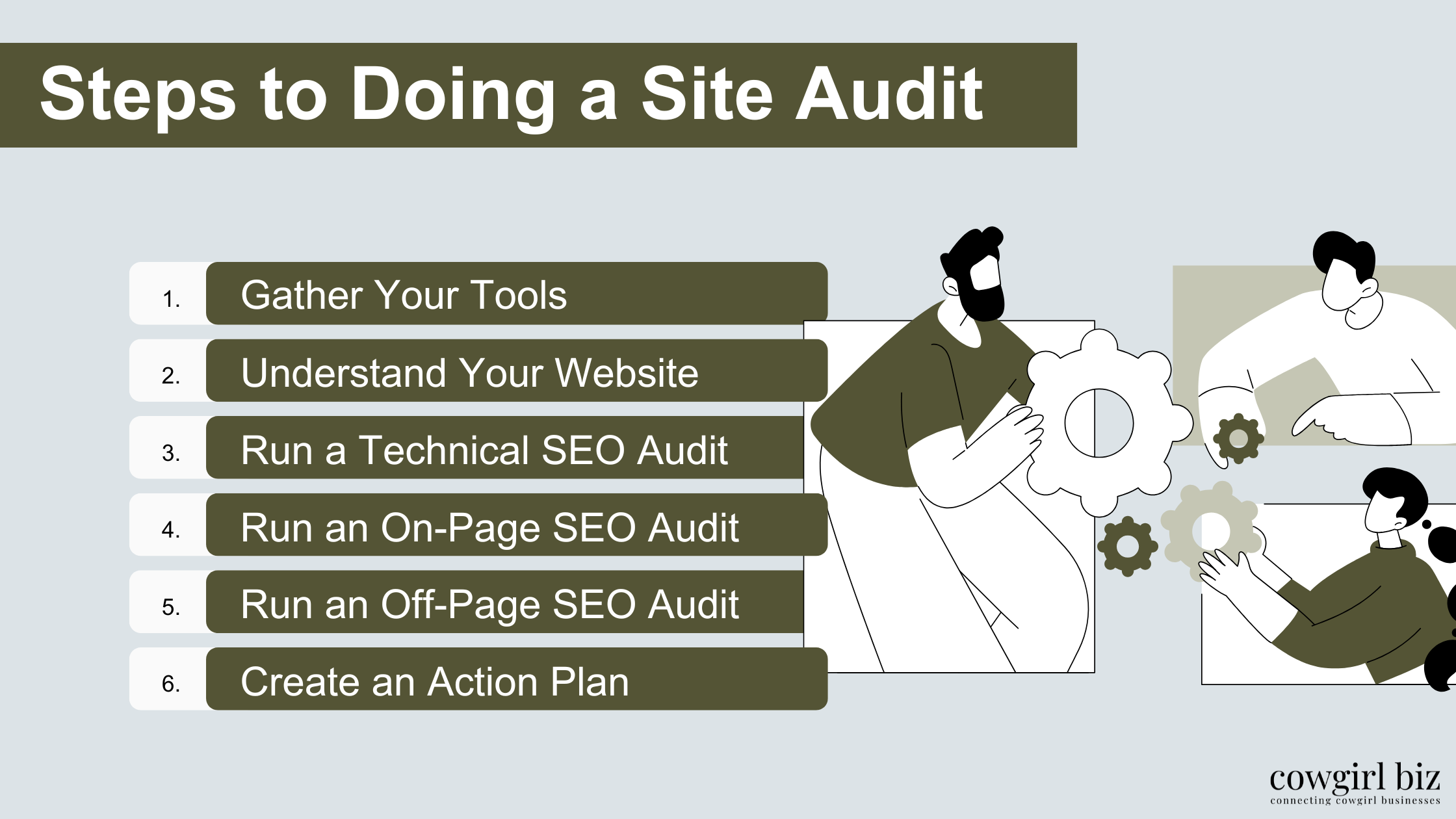
What Is an SEO Audit?
An SEO audit checks how well your website performs for search engines. It identifies errors holding you back. Think of it as inspecting your ranch before a big cattle show—it finds cracks in the fence. This process uncovers opportunities to boost your visibility and reach more customers. From site speed to keyword gaps, it digs deep.
The goal?
Fix the issues, attract more visitors, and rank higher. With better rankings, you’ll pull in more traffic and improve your business success. Keep your digital presence as strong as your favorite boots.
What SEO Audit Tools Do You Need?
A solid SEO audit relies on real, reliable data. This includes your site’s health, traffic, and backlinks. It also involves understanding how your competitors are performing. Like saddling up for a trail ride, the right tools make all the difference.
Here are two must-have tools for your SEO audit:
- Semrush: This all-in-one SEO toolkit gives you a detailed view of your site’s performance. The Site Audit feature checks for over 140 on-page and technical SEO issues. It’s like having a ranch hand who spots every loose board and rusty hinge.
- Google Search Console: Think of this as your trail map. It shows reports and dashboards to track your site’s presence on Google. It also helps identify and fix issues that could hold you back.
Let’s dig deeper into using these tools to improve your SEO.
How to Do an SEO Audit?
SEO audits focus on improving your website’s performance. Here are the areas you’ll need to cover:
- Indexing and Crawlability
- Site Architecture
- Keyword Research
- On-Page SEO
- Backlink Analysis
Not sure where to start? We’ve simplified the process into easy, actionable steps.
In a hurry? Use this essential checklist to kick off your SEO audit.

Steps to Doing a Site Audit
Before you start, know your website’s goals and audience. Like prepping your horse for a rodeo, groundwork matters. With the right tools, you can analyze and improve your site’s performance. Let’s break it down step by step.
Step 1: Gather Your Tools
To perform a site audit, you need the proper tools. They help you examine search visibility and uncover issues. Here’s what you’ll need:
- SEO Crawlers: Tools like Screaming Frog reveal technical issues, such as crawl errors and duplicate content. Think of it as checking your fences for gaps.
- Page Speed Testers: Use Pingdom or WebPageTest to measure site speed. Faster sites rank better, like a smooth gallop winning the race.
- Backlink Analysis: Tools like Ahrefs, SEMrush, or Moz analyze your backlinks. Strong backlinks are like trusted referrals in your cowgirl network.
- Keyword Research Tools: Google Keyword Planner helps you identify valuable keywords. Focus your efforts where your audience is searching.
- Rank Tracking: SEMrush, Moz, or Sensor Tower tracks keyword rankings over time. Monitor your progress like marking trails on a map.
- HTML Editor: Tools like NotePad++ allow you to review source code. It’s like inspecting the foundation of a barn.
- Accessibility Checkers: WAVE or SiteImprove ensures your site is accessible to all users. An inclusive site performs better.
- Competitive Analysis Tools: SEMrush and Ahrefs help you compare your site to competitors. Identify gaps and opportunities, like spotting open range for new growth.
The tools you choose depend on your budget, goals, and expertise. Select ones that fit your needs and provide actionable data. The right tools are as essential as a good saddle—without them, the ride gets bumpy.
Step 2: Understand Your Website
Start by making your website’s purpose, audience, and goals clear. Think of it like planning a rodeo—it begins with understanding your event’s purpose.
Ask Yourself:
- What are your website’s goals?
Are you aiming to generate leads, boost sales, or grow brand awareness? Identifying this helps focus your efforts. - What are your target keywords?
What words are your customers searching for to find businesses like yours? These guide your content strategy.
What’s your current SEO performance?
How is your site doing in search rankings? Tools like Google Search Console and Ahrefs can show you.
Tips for Understanding Your Website:
- Review analytics data: See how visitors find your site and which pages they explore most.
- Use keyword tools: Research target keywords, check competition, and gauge search volumes for better optimization.
- Check your backlink profile: Evaluate who links to your site and the quality of those links.
Having this knowledge sets the stage for your audit. It’s like knowing the layout of the ranch—it gives you the foundation to build and improve.
Step 3: Run a Technical SEO Audit
A technical SEO audit is essential for your site’s success. Think of it as checking your ranch for strong fences and safe trails—it ensures everything is in working order.
Crawlability and Indexability
Start by ensuring search engines can find and index your site. Without this, it’s like locking your gate—nobody can get in.
Here’s how to check:
- Use a site crawler to spot errors.
- Review your robots.txt file to ensure important pages aren’t blocked.
- Verify your sitemap is accurate and up-to-date.
Technical Errors
Next, find and fix any technical errors that could hurt your rankings. These include:
- 404 errors and broken links.
- Duplicate content that confuses search engines.
- Slow-loading pages that frustrate visitors.
Mobile-Friendliness
With mobile search growing, your site must work well on smaller screens. It’s like having a versatile saddle that fits any horse.
Here’s what to do:
- Use a mobile-friendly test tool to evaluate your site.
- Optimize your layout and content for mobile users.
Security Issues
Finally, check your site’s security. A secure site builds trust, like a sturdy barn for your prized horses.
Focus on these areas:
- Update outdated software to prevent vulnerabilities.
- Strengthen passwords to protect sensitive information.
- Scan for malicious code that could harm your visitors.
A thorough technical audit keeps your site running smoothly. It’s the foundation for a strong online presence, setting you up for long-term success.

Step 4: Run an On-Page SEO Audit
An on-page SEO audit ensures your pages are optimized for content and structure. Think of it as grooming your horse before the big show—it’s about making everything presentable and functional.
Key Elements to Analyze
- Title Tags and Meta Descriptions
Each page needs unique, keyword-rich titles and meta descriptions. These improve click-through rates and rankings. - Keyword Usage
Check your content for appropriate keyword placement. Avoid overstuffing, but make sure your keywords are visible. - Content Quality
High-quality content ranks better. Ensure your pages offer valuable, in-depth, and useful information for your audience. - Image Optimization
Use descriptive alt text for images. Maintain a good balance between images and text on each page. - Headings and Subheadings
Properly structure content with heading tags. Use keywords in headings to emphasize key topics. - Internal Linking
Review internal links to strengthen page connections. Ensure link juice flows to the most important pages. - UI and Navigation
Make navigation intuitive. Include clear calls-to-action to guide visitors and boost conversions.
Focusing on these elements improves user experience and search visibility. Tackle on-page issues first before diving into link building. It’s like making sure your saddle is secure before hitting the trail.
Step 5: Run an Off-Page SEO Audit
An off-page SEO audit is about building your reputation beyond your ranch. It’s like earning respect at the county fair—your influence comes from how others talk about you.
Backlinks
Backlinks are like recommendations from respected neighbors. They show search engines that your site is reliable and worth visiting.
How to check your backlinks:
- Use tools (like Ahrefs) to count how many “neighbors” are vouching for you.
- Look at the quality of these recommendations. Are they from trustworthy sources or the wrong crowd?
- Spot any harmful links—like a fence that’s letting in coyotes—and remove them.
Social Media Presence
Your social media is like showing up at the local rodeo. The more active you are, the more folks notice and follow.
What to check:
- Count your followers. Are you growing your online posse?
- Review how often you post—consistency keeps your “herd” engaged.
- Check engagement levels. Are your posts getting likes, comments, and shares?
Brand Mentions
When others talk about your brand online, it’s like hearing your name praised around the campfire. Mentions boost awareness and trust.
How to track brand mentions:
- Use tools (like Google Alerts) to find out where and how often people are mentioning you.
- Check the tone of these mentions—are they singing your praises or raising concerns?
- Address negative mentions quickly, like fixing a broken fence before it causes trouble.
An off-page audit reveals how the world outside your ranch sees you. By strengthening backlinks, social media, and brand mentions, you’ll build a solid reputation. It’s like earning blue ribbons at every show—you’ll stand out in the best way.
Step 6: Create an Action Plan
Now that you’ve uncovered your website’s SEO issues, it’s time to take action. Think of this as mapping out a trail ride—you need a clear plan to reach your destination.
Identify the Most Important Issues
Focus on what will make the biggest impact. Prioritize problems that hurt your SEO the most.
Prioritize Your Fixes
Decide what to fix first. Start with high-priority issues, then tackle the rest step by step.
Create a Timeline for Implementation
Set realistic deadlines. A clear timeline helps you stay on track and measure your progress.
Tips for Building Your Action Plan
- Be Specific
Clearly define each issue. Specific details help you prioritize and create an effective plan. - Be Realistic
Set achievable deadlines. Avoid overloading yourself with unrealistic goals. - Be Flexible
Expect surprises. Stay ready to adjust your plan if something unexpected happens.
What to Include in Your Plan
- A list of issues to fix.
- Priority rankings for each issue.
- A timeline with specific deadlines.
- The resources you’ll need.
- A plan to monitor progress.
An action plan keeps you organized and focused. It’s like a checklist for preparing your ranch—it ensures you cover every detail. Step-by-step progress and consistent effort are key to improving your site’s visibility over time. Stay committed, and the results will follow.
Boost Your Cowgirl Website’s SEO Performance
An SEO audit evaluates a website’s health and optimization to improve search visibility. It reviews technical issues, on-page content, and off-page links. The process identifies problems, prioritizes fixes, and creates a clear action plan.
Regular audits catch issues early and track progress, helping your site rank higher, attract more traffic, and drive consistent leads and sales.


